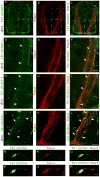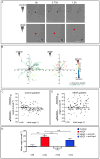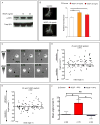VEGF mediates commissural axon chemoattraction through its receptor Flk1
- PMID: 21658588
- PMCID: PMC3638787
- DOI: 10.1016/j.neuron.2011.04.014
VEGF mediates commissural axon chemoattraction through its receptor Flk1
Erratum in
-
VEGF Mediates Commissural Axon Chemoattraction through Its Receptor Flk1.Neuron. 2023 Apr 19;111(8):1348. doi: 10.1016/j.neuron.2023.03.029. Neuron. 2023. PMID: 37080170 No abstract available.
Abstract
Growing axons are guided to their targets by attractive and repulsive cues. In the developing spinal cord, Netrin-1 and Shh guide commissural axons toward the midline. However, the combined inhibition of their activity in commissural axon turning assays does not completely abrogate turning toward floor plate tissue, suggesting that additional guidance cues are present. Here we show that the prototypic angiogenic factor VEGF is secreted by the floor plate and is a chemoattractant for commissural axons in vitro and in vivo. Inactivation of Vegf in the floor plate or of its receptor Flk1 in commissural neurons causes axon guidance defects, whereas Flk1 blockade inhibits turning of axons to VEGF in vitro. Similar to Shh and Netrin-1, VEGF-mediated commissural axon guidance requires the activity of Src family kinases. Our results identify VEGF and Flk1 as a novel ligand/receptor pair controlling commissural axon guidance.
Copyright © 2011 Elsevier Inc. All rights reserved.
Figures






Comment in
-
VEGF shows its attractive side at the midline.Neuron. 2011 Jun 9;70(5):808-12. doi: 10.1016/j.neuron.2011.05.020. Neuron. 2011. PMID: 21658576 Free PMC article.
References
-
- Avantaggiato V, Orlandini M, Acampora D, Oliviero S, Simeone A. Embryonic expression pattern of the murine figf gene, a growth factor belonging to platelet-derived growth factor/vascular endothelial growth factor family. Mech Dev. 1998;73:221–224. - PubMed
-
- Baldwin ME, Catimel B, Nice EC, Roufail S, Hall NE, Stenvers KL, Karkkainen MJ, Alitalo K, Stacker SA, Achen MG. The specificity of receptor binding by vascular endothelial growth factor-d is different in mouse and man. J Biol Chem. 2001;276:19166–19171. - PubMed
-
- Bellon A, Luchino J, Haigh K, Rougon G, Haigh J, Chauvet S, Mann F. VEGFR2 (KDR/Flk1) signaling mediates axon growth in response to semaphorin 3E in the developing brain. Neuron. 2010;66:205–219. - PubMed
-
- Bocker-Meffert S, Rosenstiel P, Rohl C, Warneke N, Held-Feindt J, Sievers J, Lucius R. Erythropoietin and VEGF promote neural outgrowth from retinal explants in postnatal rats. Invest Ophthalmol Vis Sci. 2002;43:2021–2026. - PubMed
-
- Carmeliet P, Ferreira V, Breier G, Pollefeyt S, Kieckens L, Gertsenstein M, Fahrig M, Vandenhoeck A, Harpal K, Eberhardt C, et al. Abnormal blood vessel development and lethality in embryos lacking a single VEGF allele. Nature. 1996;380:435–439. - PubMed
Publication types
MeSH terms
Substances
Grants and funding
LinkOut - more resources
Full Text Sources
Other Literature Sources
Molecular Biology Databases
Miscellaneous

